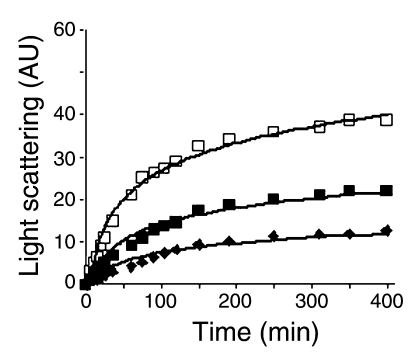Figure 5.
Caspase-cleavage of tau drives filament formation of full-length tau in vitro. Laser light scattering was used to assess tau filament formation in vitro. Equimolar (4 μM) amounts of ΔTau (filled squares), full-length tau (filled diamonds), or a 3:1 ratio of full-length tau to ΔTau (open squares) were monitored over 400 minutes. ΔTau (filled squares) scattered light (arbitrary units [AU]) more rapidly and to a greater degree than full-length tau (filled diamonds), indicating increased filament formation. Most interestingly, a 3:1 ratio of full-length tau to ΔTau (open squares) dramatically accelerated light scattering, suggesting that ΔTau may nucleate the assembly of full-length tau filaments.

